FigJam is a popular collaborative whiteboarding tool recognized for its user-friendly interface and focus on team brainstorming and idea sharing. However, it might not meet every user’s needs, especially those seeking proper diagramming features, broader integrations, or more competitive pricing. If you’re considering switching from FigJam or looking for FigJam alternatives that better align with your workflow and team requirements, this guide is here to help. Let’s dive into the top FigJam alternatives and see how they compare!
Why Figjam May Not Be the Best Whiteboarding Tool:
1. Feature Gaps
While FigJam excels in creative brainstorming and ideation, it doesn’t cater well to advanced diagramming or technical visualizations. Figjam is simple but can sometimes lack depth for instance, creating process maps, detailed flowcharts, or network diagrams might require more specialized tools with robust functionality. Teams working on workflows that demand precision and depth may feel limited by FigJam’s capabilities, which focus more on freeform collaboration than structured design.
2. Ends at Brainstorming
FigJam is designed with smaller, agile teams in mind, making it an excellent choice for quick brainstorming sessions. However, it lacks the advanced features necessary for scaling workflows or managing larger, more complex projects. As teams expand and require more structured tools for project tracking, collaboration, or diagramming, FigJam may fall short. Teams needing detailed progress tracking, interlinked workflows, or standardized templates might find that FigJam’s features stop short of meeting these needs.
3. Challenges with Scaling
FigJam is designed with smaller, agile teams in mind, making it an excellent choice for quick brainstorming sessions. However, as teams scale and workflows become more complex, FigJam’s feature set may struggle to keep up. For example, managing multiple interconnected boards, tracking progress across projects, or implementing standardized workflows can become cumbersome. Teams requiring tools that grow with their organizational needs might find FigJam less suitable for handling larger-scale collaboration and more structured processes.
4. Narrow Integration Options
While FigJam integrates effortlessly within the Figma ecosystem, its support for third-party integrations is less extensive compared to other tools. This can be a significant limitation for teams that rely on diverse tools like CRM platforms, advanced project management software, or external communication apps. The lack of broader integration options can make it challenging to fully integrate FigJam into workflows that demand interoperability across a variety of tools.
5. Limited Template Variety
FigJam’s template library is tailored for brainstorming, team collaboration, and ideation. However, teams requiring templates for industry-specific workflows, such as business process analysis, product roadmaps, or technical schematics, may find its offerings inadequate. This lack of template depth can force users to spend more time building designs from scratch, which is inefficient compared to tools with a more comprehensive template catalog.
Imagine a growing design team starting with FigJam for their brainstorming sessions. As the team expands and takes on more complex projects, they find it increasingly difficult to manage their workflows. The lack of structure and templates makes tracking progress across projects and coordinating between multiple departments challenging. A project manager may struggle to establish a unified process when FigJam’s tools are not equipped for enterprise-level demands. complexity.
6. Pricing Concerns
FigJam offers a sleek and modern tool, but its pricing model can become burdensome for teams that require extensive features or manage larger collaboration efforts. Small businesses, startups, or freelance professionals might find the costs challenging to justify, especially when free or lower-cost FigJam alternatives offer comparable capabilities. For organizations with tight budgets, the cumulative subscription costs can make FigJam a less sustainable option.
| Feature | FigJam | Creately | Miro | Mural | Lucidchart | Microsoft Visio | SmartDraw |
|---|---|---|---|---|---|---|---|
| Real-time collaboration | ✅ | ✅ | ✅ | ✅ | ✅ | ✅ | ✅ |
| Extensive templates | ✅ | ✅ | ✅ | ✅ | ✅ | ✅ | ✅ |
| Diagram type support | ✅ (15+ types) | ✅ (70+ types) | ✅ (40+ types) | ✅ (15+ types) | ✅ (50+ types) | ✅ (25+ types) | ✅ (35+ types) |
| Custom databases | ❌ | ✅ | ❌ | ❌ | ❌ | ❌ | ❌ |
| AI-powered features | ✅ | ✅ | ✅ | ✅ | ✅ | ❌ | ❌ |
| Ease of use | Easy | Easy | Moderate | Moderate | Moderate | Moderate | Moderate |
| Presentation tools | ✅ | ✅ | ❌ | ✅ | ❌ | ❌ | ✅ |
| Visual modeling | ❌ | ✅ | ❌ | ❌ | ❌ | ❌ | ❌ |
| Item-level notes & attachments | ❌ | ✅ | ❌ | ❌ | ❌ | ❌ | ❌ |
| Template count | ✅ (500+) | ✅ (9,000+) | ✅ (1,000+) | ✅ (500+) | ✅ (1,000+) | ✅ (500+) | ✅ (400+) |
| Pricing (starting) | Free/$5 per user/mo | Free/$5 per user/mo | Free/$8 per user/mo | Free/$12 per user/mo | Free/$7.95 per mo | Free (with MS 365) | Free/$9.95 per mo |
| Best for | Brainstorming | All-in-one | Versatility | Workshops | Detailed diagrams | Microsoft users | Professional use |
Top 6 Figjam Alternatives
When considering FigJam alternatives, it’s essential to evaluate each tool’s key features, limitations, pricing, and user feedback. Here’s an overview of eight of the notable FigJam alternatives:
Creately
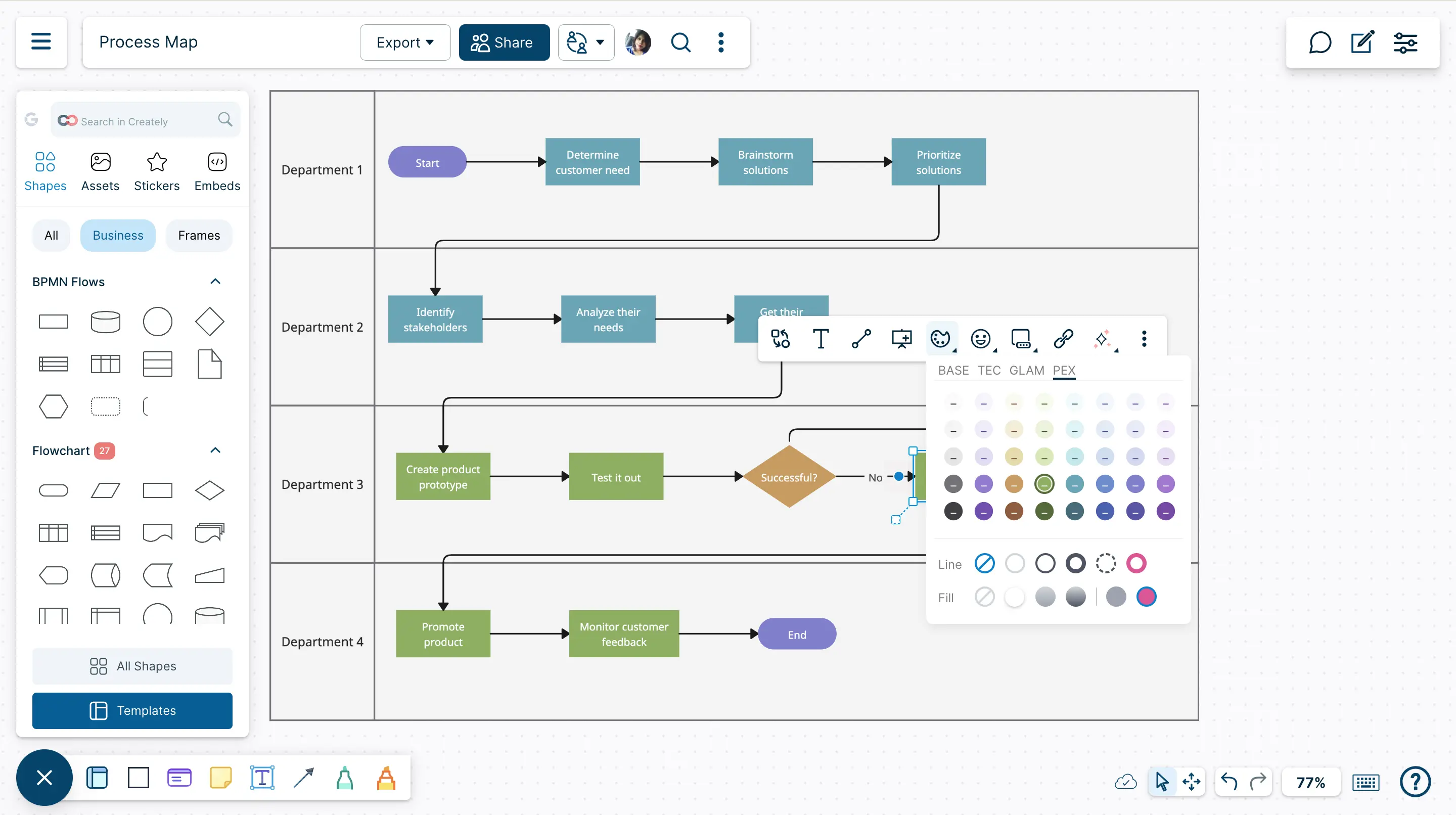
When searching for FigJam alternatives, it’s crucial to consider tools that not only match its collaborative features but also offer expanded capabilities for teams that require more than just a whiteboarding solution. While FigJam excels at facilitating brainstorming sessions and real-time collaboration, its limitations become apparent as teams scale and their needs grow.
Enter Creately, a visual collaboration and work management platform designed to streamline workflows and enhance team collaboration. Unlike FigJam, which focuses mainly on freeform ideation and basic diagramming, Creately offers a comprehensive suite of tools that cater to both creative and organizational needs. Whether you’re managing tasks, building detailed diagrams, or integrating with other tools, Creately ensures a seamless experience that goes beyond just drawing on a virtual board.
Creately combines intuitive diagramming tools, smart integrations, and custom database capabilities in one user-friendly interface. When considering FigJam alternatives, Creately stands out by offering a complete solution designed to streamline workflows and foster team collaboration. It goes beyond the capabilities of a typical online whiteboard, making it an ideal choice for teams that need a versatile tool for their collaborative needs. As a top contender among FigJam alternatives, Creately enables teams to work smarter, not harder, with an all-in-one platform that supports a wide range of collaborative tasks.
Key Features
Intuitive Interface: Creately’s user-friendly layout ensures teams can focus on their ideas rather than grappling with complex software, unlike FigJam, which can become overwhelming when scaling to more structured processes.
Real-time Collaboration: Similar to FigJam, Creately allows multiple users to collaborate simultaneously on projects. However, Creately goes a step further by offering real-time commenting and editing across a wide range of diagrams, ensuring smooth collaboration regardless of team size.
Extensive Templates: Creately offers a vast library of templates for everything from flowcharts to org charts and wireframes. While FigJam provides basic templates for brainstorming and ideation, Creately’s broader range makes it ideal for teams working on more structured, complex projects.
Custom Databases: Unlike FigJam, which focuses more on brainstorming and idea-sharing, Creately allows teams to move beyond static visuals and design custom databases to track resources, relationships, and workflows, making it a great choice for managing detailed projects.
Task Tracking: Creately includes built-in tools for task assignment, deadline setting, and progress tracking within diagrams, ensuring teams stay organized and on schedule. This feature is especially useful compared to FigJam, where task management is not a built-in feature.
Custom Shapes and Libraries: Creately lets you design custom shapes or create a library of reusable components tailored to your specific needs. While FigJam offers a creative canvas, Creately’s flexibility in creating specialized elements can enhance the precision of visual representations.
Smart Data Integration: Creately integrates with tools like Google Sheets, Slack, and Confluence, making it easy to sync data and communications. This level of integration is a step up from FigJam, where third-party integrations are more limited.
AI-powered Tools: (Creately VIZ)[https://creately.com/creately-ai/] simplifies repetitive tasks, generates visuals based on user input, and even offers suggestions for improvement. This AI integration enhances productivity, especially compared to FigJam, which lacks this level of automation.
Presentation Mode: Quickly convert your work into a professional presentation within Creately. FigJam’s presentation features are more basic, while Creately offers a smoother and more structured way to showcase your ideas to stakeholders.
Interactive Elements: Creately supports interactive features like embedded links, videos, and live data feeds, providing a more dynamic and engaging collaboration experience compared to FigJam’s more static canvas.
Voting and Decision-Making: Creately enables team members to vote on ideas or proposals directly within the platform, making collaborative decision-making faster and more inclusive. FigJam lacks an integrated voting feature, which can slow down group decision processes.
Explore all the powerful features of Creately, from diagramming and project management to real-time collaboration, and start your free trial today. No credit card required—just sign up and get started.
Limitations
Advanced Features: Some of Creately’s advanced functionalities, like custom databases and AI tools, may require a learning curve, especially for teams used to simpler tools like FigJam.
Offline Access: Creately offers limited offline functionality, similar to FigJam, which is something teams need to consider when working in low-connectivity environments.
Pricing
Free Plan
Personal: $5/month
Team: $5/month per user
Business: $89/month
Enterprise: Custom pricing
Ratings/Reviews
G2: 4.4/5 (based on 175 reviews)
Capterra: 4.4/5 (based on 175 reviews)
Verdict:
While FigJam is great for brainstorming and real-time collaboration, Creately offers a more comprehensive suite of tools that adapts to complex workflows, making it ideal for teams that need more than just a whiteboarding platform. As a top choice among FigJam alternatives, Creately’s advanced diagramming capabilities, task tracking, database design, and integration features provide a more robust solution for teams scaling their projects or working with data-driven processes. If you’re looking for a platform that supports not just collaboration, but also organization, management, and presentation, Creately is a strong contender among FigJam alternatives.
Lucidchart
Best for: Teams requiring advanced diagramming tools for technical or process-driven projects.
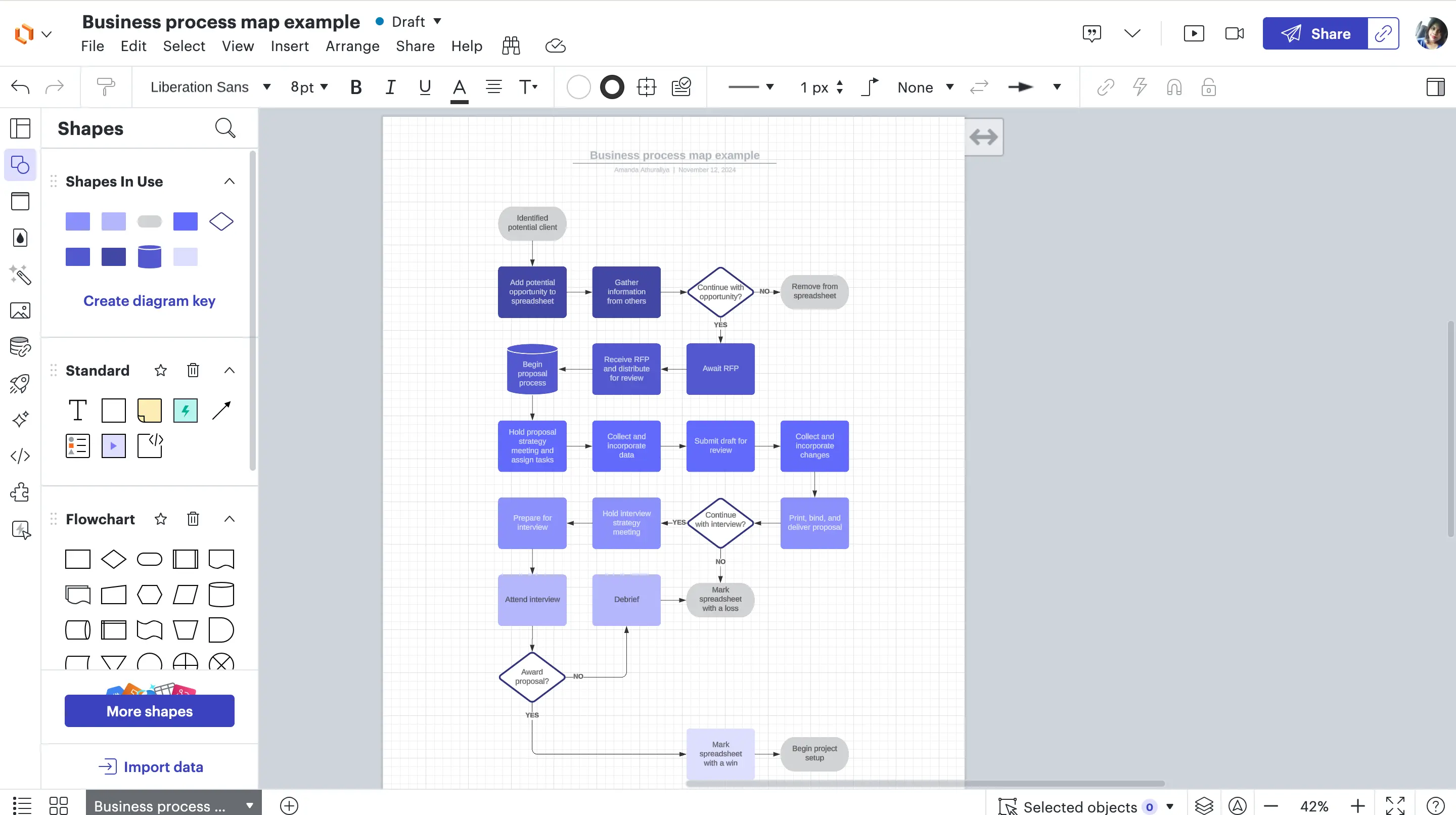
Lucidchart is a widely recognized diagramming platform known for its ability to create complex diagrams and detailed visualizations. While FigJam excels at brainstorming and creative collaboration, Lucidchart stands out for teams that need to create in-depth, structured diagrams such as flowcharts, org charts, and network diagrams. However, it’s important to note that while Lucidchart offers powerful features, its complexity and pricing can make it less ideal for those looking for a simpler, cost-effective FigJam alternative. For those seeking a more straightforward and budget-friendly option, other FigJam alternatives may be better suited to their needs.
Key Features
Advanced Diagramming: Lucidchart offers a broad range of diagramming tools, making it perfect for creating intricate visual representations of workflows, business processes, and technical systems.
Real-time Collaboration: Lucidchart supports live editing and comments, allowing multiple users to work on diagrams simultaneously, similar to FigJam, but with more robust collaboration features suited for detailed work.
Integration Options: Lucidchart integrates seamlessly with tools like Google Drive, Slack, and Microsoft Teams, ensuring that your workflows remain synchronized across platforms.
Pre-designed Templates: Quickly get started with a variety of templates, designed to help teams create professional diagrams without starting from scratch.
Cross-device Access: Whether you’re working on a computer, tablet, or mobile, Lucidchart ensures you can access and edit your diagrams from anywhere.
Limitations
Complexity: Lucidchart’s advanced features and extensive tools can feel overwhelming, especially for teams that are used to simpler, more intuitive platforms like FigJam. New users might find the learning curve steep, which could slow down adoption.
Pricing: Unlike FigJam, which offers a straightforward pricing model, Lucidchart’s advanced features are locked behind higher-tier plans, which can make it cost-prohibitive for smaller teams or individuals.
Performance with Large Diagrams: As with other diagramming tools, Lucidchart may experience performance issues when working with very large or complex diagrams, which can hinder user experience during heavy collaboration sessions.
Pricing
Free Plan
Individual: $9/month
Team: $10/user/month
Enterprise: Custom pricing
Ratings/Reviews
G2: Rated 4.5/5 based on 2,124 reviews
Capterra: Rated 4.5/5 based on 2,124 reviews
Consider Lucid If you Want More Diagaming and Less Brainstorming
If your team is moving beyond brainstorming sessions and requires a more technical, structured approach to diagramming, Lucidchart offers the advanced features needed for detailed visualization. However, teams looking for a simpler, cost-effective solution might find FigJam’s more intuitive interface and lower pricing model more appealing. Lucidchart is best suited for those needing robust diagramming capabilities but may not be the ideal FigJam alternative for teams seeking a more lightweight collaboration tool. For those in search of a more flexible, budget-friendly FigJam alternative, other options may be a better fit.
ClickUp
Best for: Teams looking for integrated task management within a collaboration platform..

ClickUp is a powerful project management tool designed to combine task tracking, collaboration, and visualization in one unified platform. While FigJam is focused primarily on brainstorming and freeform collaboration, ClickUp offers a comprehensive solution for teams that require deeper project management functionality. It’s ideal for teams seeking a centralized tool to manage tasks, deadlines, and workflows, but its extensive features can be overwhelming for those looking for a more streamlined or lightweight collaboration tool.
Key Features
Task and Workflow Management: ClickUp allows teams to manage tasks, set deadlines, track progress, and prioritize work all in one place. This makes it a stronger alternative for teams that require more organization and task-focused collaboration compared to FigJam’s simpler, brainstorming-oriented tools.
Built-in Whiteboards: Just like FigJam, ClickUp offers whiteboarding features for visual collaboration and brainstorming. However, ClickUp’s whiteboards are designed to be integrated into its project management system, allowing teams to turn ideas into actionable tasks directly from the board.
Customizable Workflows: ClickUp allows teams to tailor workflows with custom statuses, views, and task automation. This level of customization can be highly beneficial for teams managing complex projects, but might be a challenge for those used to FigJam’s more free-flowing environment.
Integration with Popular Tools: ClickUp integrates seamlessly with tools like Slack, Google Drive, and Zoom, ensuring that all your team’s communication and data remain connected. This is a step beyond FigJam’s integration options, which are more limited and focused primarily on Figma and related tools.
Multiple Views for Project Management: ClickUp offers several views to manage projects, including Gantt charts, Kanban boards, calendars, and lists. This versatility makes it a great choice for teams looking to combine project management with visual collaboration, but might feel like overkill for teams just looking for brainstorming tools like those offered by FigJam.
Pre-built Templates: ClickUp provides a variety of templates for project management, sprint planning, and more, allowing teams to quickly get started with structured processes. While FigJam offers templates for brainstorming and ideation, ClickUp’s templates are better suited for complex project management needs.
Limitations
Steep Learning Curve: While ClickUp’s features are extensive, the platform can feel overwhelming for new users or smaller teams unfamiliar with project management tools. This makes it less approachable for teams used to the simplicity and ease of use that FigJam offers.
Performance Issues: Some users report occasional slowdowns, especially when handling large amounts of data or working on complex projects. This could be a barrier for teams seeking smooth collaboration, unlike FigJam’s simpler, more agile experience.
Over-customization: ClickUp’s high level of customization can be both a strength and a drawback. Setting up workflows and configuring the platform to fit your team’s exact needs can require time and effort, making it more cumbersome compared to the more straightforward, out-of-the-box usability that FigJam provides.
Pricing
Free Plan
Unlimited: $7/user/month
Business: $12/user/month
Enterprise: Custom pricing
Ratings/Reviews
G2: Rated 4.7/5 (based on 4,000+ reviews)
Capterra: Rated 4.7/5 (based on 4,000+ reviews)***
For Larger More Established Teams
If your team needs a powerful tool to manage tasks alongside visual collaboration, ClickUp offers a more structured, all-in-one platform. While FigJam is great for brainstorming and ideation, ClickUp takes project management and team collaboration to the next level by combining task tracking, customizable workflows, and multiple project views in one tool. However, if your team values simplicity and a lighter interface for creative collaboration, FigJam’s focused approach may be a better fit. For teams looking for more advanced features and comprehensive task management, ClickUp can be a strong FigJam alternative, offering greater versatility and scalability.
Mural
Best for: Creative teams and educators looking to inspire innovation
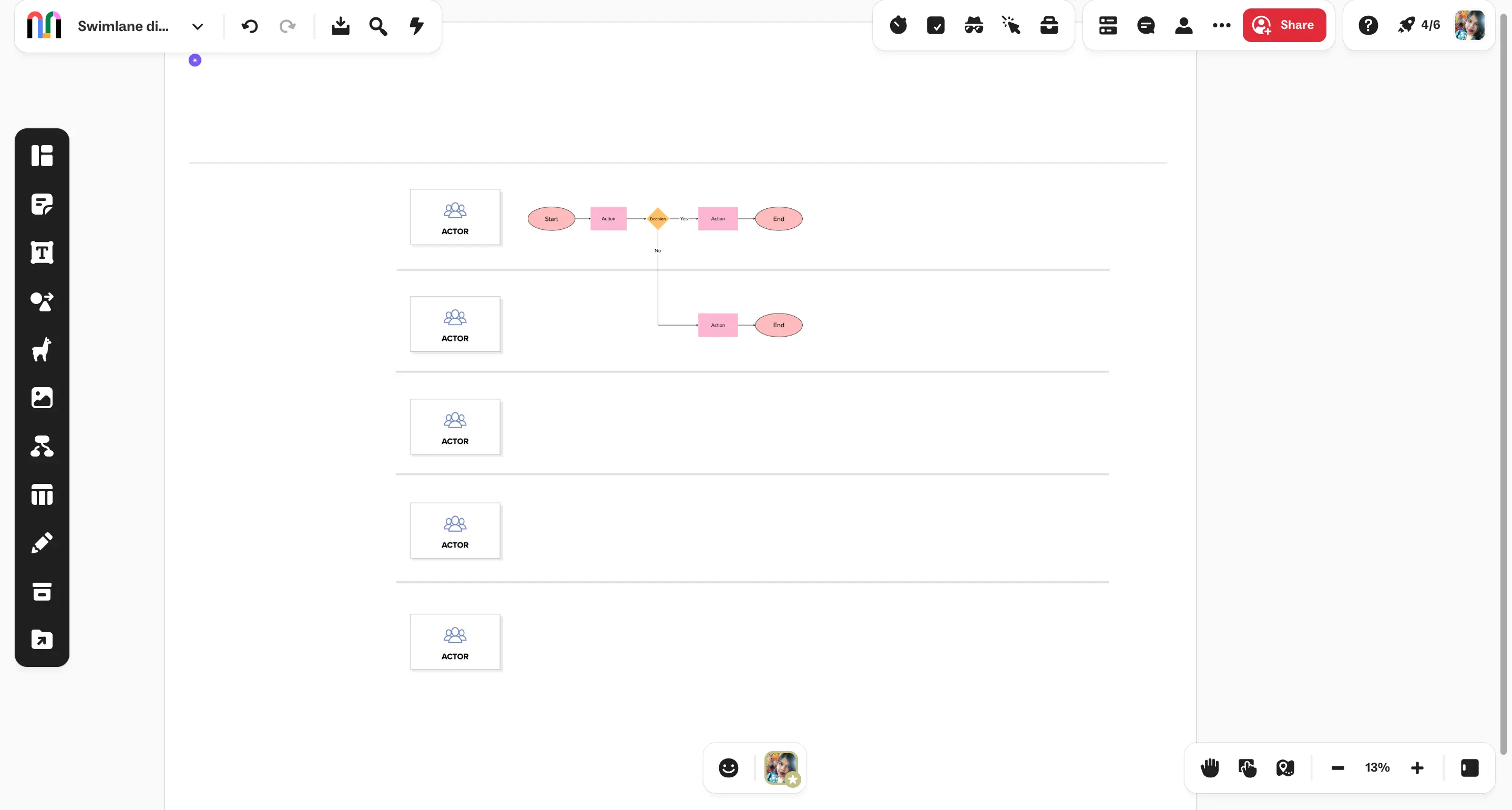
Mural is a digital whiteboarding tool designed to foster creativity and collaboration within teams. It excels in structured workshops, brainstorming sessions, and team discussions, making it an excellent choice for groups focused on idea generation and collaborative innovation. While FigJam is great for real-time, freeform brainstorming, Mural takes it a step further by offering specific tools for facilitation and structured collaboration, especially for creative teams or educators looking to guide productive team activities.
Key Features
Facilitation Tools: Mural stands out with its facilitation features like voting, timers, and private modes, designed to structure workshops and brainstorming sessions. This is particularly helpful for teams who need to manage interactive sessions and decision-making processes, which FigJam lacks.
Pre-built Templates: Mural provides a rich library of templates for various use cases, such as retrospectives, design sprints, and team planning. These templates are ideal for teams looking to quickly jumpstart structured activities, a feature that FigJam’s basic templates may not fully support.
Real-time Collaboration: Like FigJam, Mural allows multiple users to collaborate simultaneously using sticky notes, freehand drawing, and comments. However, Mural takes this further with built-in tools designed specifically for team coordination and interactive discussions.
Integration with Communication Tools: Mural integrates with tools like Microsoft Teams, Zoom, and Slack, enhancing communication during sessions. FigJam has fewer integration options, primarily focused around Figma and other design tools.
Multi-device Support: Whether you’re working on desktop, mobile, or web, Mural ensures that your team can collaborate seamlessly across devices. This flexibility helps maintain collaboration no matter where team members are located.
Visualization Tools: Mural offers mind maps, flowcharts, and other visualization tools to help teams organize and structure their ideas effectively, whereas FigJam provides a simpler, more open canvas without these advanced organizational tools.
Limitations
High Cost for Full Features: Mural’s premium features are behind higher pricing tiers, which can make it less affordable for smaller teams or organizations. For teams with a limited budget, FigJam may present a more cost-effective alternative with its simpler pricing structure.
Performance Issues with Large Boards: Similar to other digital whiteboarding tools, Mural can experience performance issues when dealing with large boards containing extensive content. This can lead to slower collaboration, especially for teams working with complex visuals, whereas FigJam may perform better with simpler, smaller boards.
Pricing
Free Plan
Team: $9.99/user/month
Business: $17.99/user/month
Enterprise: Custom pricing
Ratings/Reviews
G2: Rated 4.6/5 (based on 132 reviews)
Capterra: Rated 4.6/5 (based on 132 reviews)
Looking to Run Workshops?
If your team focuses on creativity, structure, and facilitation in collaborative settings, Mural offers powerful tools to inspire innovation and ensure productive team sessions. Mural’s templates, facilitation features, and integration options make it an excellent choice for creative teams, educators, or teams running structured workshops. However, if your team prioritizes a lightweight, cost-effective solution for real-time brainstorming and basic ideation, FigJam may be the better fit.
For those looking for more advanced collaboration features, exploring FigJam alternatives like Mural may provide the tools necessary for complex facilitation. While FigJam alternatives like Mural excel in structured collaboration and workshops, they may not be as accessible or affordable for smaller teams. Teams looking for a streamlined, simple platform may prefer FigJam or other FigJam alternatives that offer a more user-friendly interface. Ultimately, for teams seeking advanced features in a collaborative platform, FigJam alternatives like Mural can be an invaluable tool, but for simplicity and cost-effectiveness, FigJam and its alternatives might be a more suitable choice.
Whimsical
Best for: Individuals or small teams needing a straightforward tool for planning.
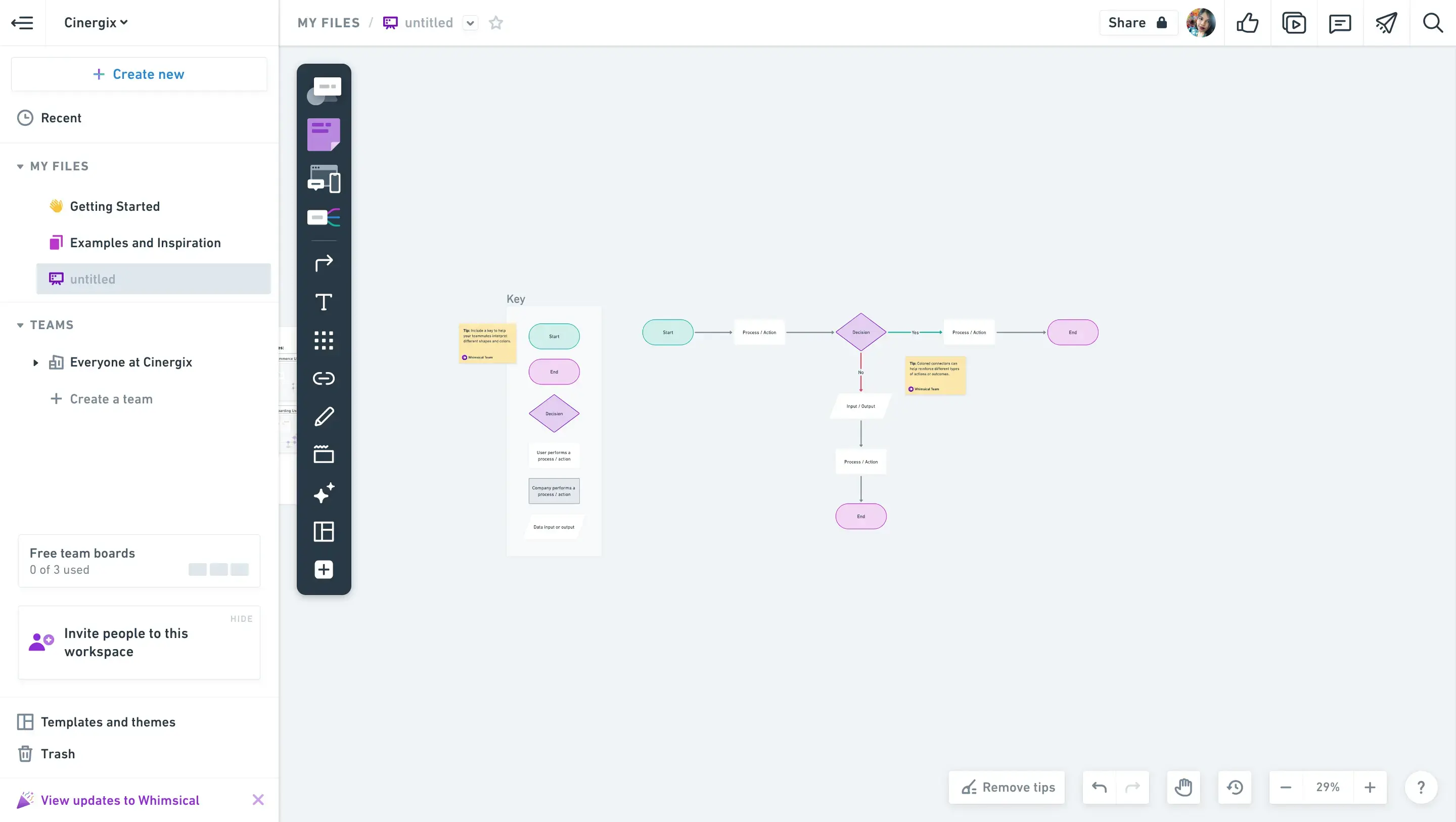
Whimsical is a lightweight visual collaboration tool designed to simplify the creation of flowcharts, mind maps, and wireframes. Its clean, intuitive interface makes it ideal for individuals or small teams who need a quick and easy platform for creating visuals and organizing ideas. Unlike FigJam, which offers a more flexible canvas for brainstorming, Whimsical focuses on providing a streamlined experience for smaller teams that require basic visual collaboration and planning tools without the complexity of larger platforms. For those seeking a more feature-rich option, exploring FigJam alternatives may be beneficial. While Whimsical excels in simplicity, it may not meet the needs of teams looking for the advanced features offered by FigJam alternatives. If you’re looking for a more comprehensive platform, there are many FigJam alternatives that provide greater scalability and flexibility. Whimsical serves as a practical FigJam alternative for those who prioritize a lightweight, no-frills approach, but for teams needing more robust capabilities, FigJam alternatives would likely offer a better fit.
Key Features
Easy-to-use Interface: Whimsical’s simple, drag-and-drop interface allows users to quickly create diagrams, making it an excellent choice for individuals or small teams who need to visualize ideas without spending too much time on setup. This contrasts with FigJam, which, while intuitive, can be more flexible and complex when scaling to larger, structured projects.
Supports Multiple Diagram Types: Whimsical allows users to create flowcharts, wireframes, mind maps, and sticky notes with ease. FigJam offers similar functionality but with a more open-ended approach to collaboration, whereas Whimsical’s focus is more specific to these structured diagram types.
Real-time Collaboration: Whimsical supports live editing and commenting, allowing for seamless collaboration, similar to FigJam. However, Whimsical’s collaborative features are simplified, making it ideal for smaller teams that don’t need advanced collaboration tools.
Drag-and-Drop Components: Users can easily drag and drop pre-built components to speed up diagram creation. This feature is ideal for those who want to avoid creating diagrams from scratch, much like FigJam’s template-based structure, but with fewer options and more simplicity.
Export Options: Whimsical offers multiple export options for easy sharing, enabling users to quickly share their visuals in various formats. FigJam also supports sharing and exporting, but Whimsical’s options are streamlined for those looking for basic exports without extra steps.
Limitations
Limited Feature Set: Compared to more robust tools like FigJam or Creately, Whimsical lacks advanced features such as database integration or extensive customization options. This makes it less suitable for teams with more complex needs.
Scalability Challenges: While Whimsical is perfect for individuals or small teams, its limited capabilities may not meet the demands of larger organizations with complex collaboration needs or highly structured workflows. FigJam, on the other hand, is more scalable, offering features that support larger teams as they grow.
No Advanced Project Management Tools: Whimsical is designed mainly for visual collaboration and doesn’t include project or resource management features. Teams that need task management, deadline tracking, or resource allocation will find FigJam or other FigJam alternatives more suitable.
Pricing
Free Plan
Pro: $12/editor/month
Org: $20/editor/month (billed annually)
Ratings/Reviews
G2: Rated 4.8/5 (based on 100+ reviews)
Capterra: Rated 4.8/5 (based on 100+ reviews)
For Small Teams Looking to Get Started
If you’re looking for a simple, easy-to-use visual collaboration tool, Whimsical is a great choice for individuals or small teams that need basic diagramming capabilities without the extra features that come with platforms like FigJam. Whimsical is perfect for quick visualizations and collaborative planning, but if your team requires more flexibility, scalability, or advanced collaboration tools, exploring FigJam alternatives like FigJam itself may be a better fit. Whimsical’s focus on simplicity may be ideal for smaller teams or solo users, but those seeking a more comprehensive tool for larger-scale collaboration will benefit from the additional features that FigJam alternatives provide. While Whimsical is a solid choice for basic collaboration, those looking for more robust options should consider other FigJam alternatives to meet their growing needs. In summary, Whimsical can be a useful FigJam alternative for specific use cases, but for teams needing advanced functionalities, FigJam alternatives will likely offer more value in the long run.
Microsoft Whiteboard
Best for: Teams using Microsoft 365 extensively.
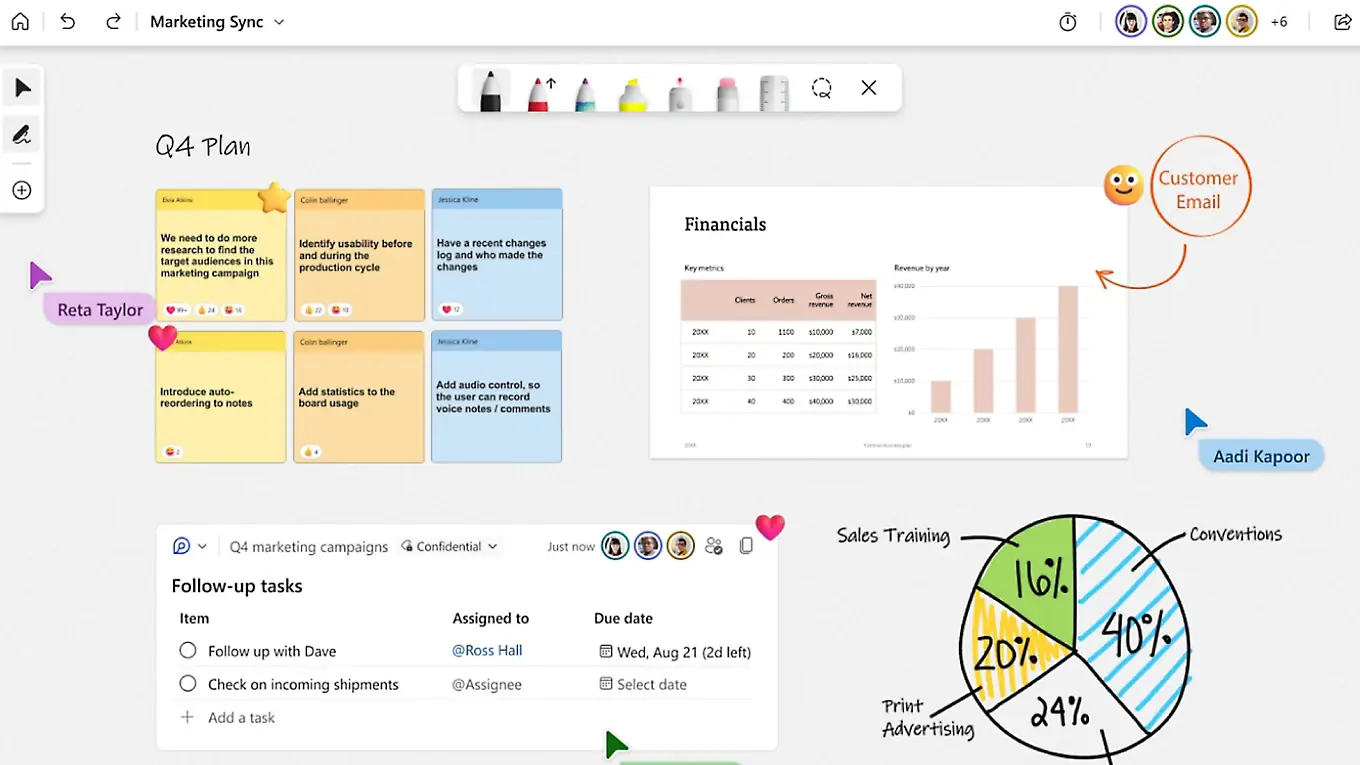
Microsoft Whiteboard is a digital whiteboarding tool integrated into the Microsoft 365 ecosystem, offering teams a straightforward platform for visual collaboration and brainstorming. While FigJam provides a more sophisticated feature set for creative teams, Microsoft Whiteboard excels in its seamless integration with Microsoft tools and simplicity for basic collaboration needs. For teams looking for a simple and efficient solution, Whiteboard may be an appealing FigJam alternative. However, if you’re seeking more advanced features for in-depth brainstorming and collaboration, exploring other FigJam alternatives could be beneficial. While Whiteboard suits organizations already invested in the Microsoft ecosystem, those needing additional diagramming tools and more robust collaboration features might find that FigJam alternatives better meet their requirements. Microsoft Whiteboard might serve as a basic FigJam alternative, but teams with evolving needs may want to consider other tools in the FigJam alternatives space.
Key features
Microsoft 365 Integration: Whiteboard integrates natively with Microsoft Teams, OneNote, and other Microsoft 365 applications, making it a natural choice for teams heavily invested in the Microsoft ecosystem. Unlike FigJam’s broader but more limited integrations, Whiteboard’s strength lies in its deep connection to Microsoft’s productivity suite.
Real-time Collaboration: Similar to FigJam, Whiteboard enables multiple users to collaborate simultaneously on a shared canvas. However, Whiteboard’s collaboration features are more basic, focusing on essential drawing, typing, and annotation tools rather than advanced creative features.
Basic Templates: Microsoft Whiteboard includes a selection of basic templates for common use cases like brainstorming and planning. While FigJam offers more diverse and customizable templates, Whiteboard’s templates are straightforward and familiar to Microsoft users.
Cross-device Support: Available on desktop, web, and mobile devices, Whiteboard allows teams to collaborate from anywhere. However, the experience is optimized for Microsoft devices and platforms, unlike FigJam’s more platform-agnostic approach.
Drawing Tools: The platform offers basic drawing and inking tools, making it suitable for quick sketches and annotations. While not as sophisticated as FigJam’s creative tools, they serve well for basic visualization needs.
Limitations
- Basic feature set: Compared to specialized tools, Microsoft Whiteboard lacks advanced features like diagram-specific elements, detailed templates, or AI-powered automation.
- Platform dependence: Delivers its best performance when used within the Microsoft ecosystem, limiting its appeal for users relying on other platforms.
- Limited export options: Sharing work outside the Microsoft suite can be cumbersome, as export features are less flexible.
- Performance issues: Users occasionally report lag on larger boards or during heavy collaboration sessions.
Pricing
- Free: Included with Microsoft 365.
- Business Plans: Start at $6.99 per user/month.
Ratings/reviews
- G2: 4.4/5 based on 145 reviews.
- Capterra: 4.4/5 based on 145 reviews.
Best for Microsoft-First Teams
For organizations already using Microsoft 365, Whiteboard provides a convenient, built-in solution for basic visual collaboration needs. While it may not match FigJam’s creative capabilities or advanced features, its integration with Microsoft tools and familiar interface make it an attractive option for teams seeking simple, accessible whiteboarding within their existing Microsoft workflow. However, teams requiring more sophisticated diagramming tools, extensive templates, or platform-agnostic collaboration might find FigJam or other FigJam alternatives more suitable for their needs. Whiteboard serves as a basic alternative, but if you need more functionality, exploring other FigJam alternatives might be the better option for your team.
Conclusion: Finding Your Ideal Collaboration Companion
Choosing the right collaboration tool is more than just selecting a platform—it’s about finding a solution that grows with your team, adapts to your workflow, and transforms how you work together. When exploring FigJam alternatives, it’s essential to consider not just the features, but how each tool enhances your team’s creativity and productivity. Each alternative we’ve explored offers unique strengths: Lucidchart’s precision for diagramming, ClickUp’s robust project management, Mural’s workshop facilitation, and Whimsical’s simplicity.
However, when weighing all considerations—features, flexibility, ease of use, integration capabilities, and cost-effectiveness—Creately emerges as a more holistic solution. It strikes an exceptional balance between powerful functionality and user-friendly design. Unlike tools that excel in only one area, Creately provides a comprehensive ecosystem that supports everything from initial brainstorming to complex project management, making it a standout FigJam alternative.
The platform’s ability to seamlessly blend real-time collaboration, advanced diagramming, task tracking, custom databases, and AI-powered tools sets it apart from traditional FigJam alternatives. For teams seeking a versatile tool that can adapt to evolving needs without overwhelming users, Creately represents not just an alternative to FigJam, but a significant upgrade in collaborative potential.
Unlike other FigJam alternatives that may be focused on niche tasks, Creately offers a more robust, all-encompassing solution that is intuitive and scalable. It ensures your team remains efficient, creative, and connected, making it an ideal choice for those looking to evolve beyond traditional FigJam alternatives.
Ultimately, the best tool is the one that feels like an extension of your team’s creativity and productivity. But for those seeking a true all-in-one solution that can scale with their ambitions, Creately stands out as a compelling FigJam alternative that promises to transform how teams visualize, plan, and execute their most innovative ideas. When you consider features and versatility, Creately stands as one of the top FigJam alternatives, ready to support both the smallest team efforts and the most complex collaborative projects.





